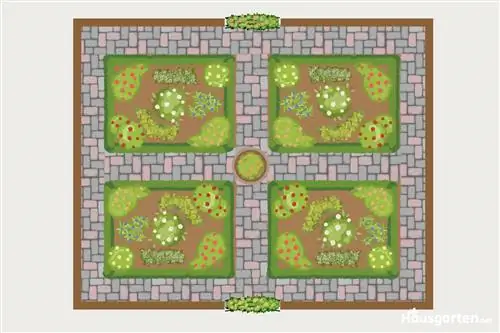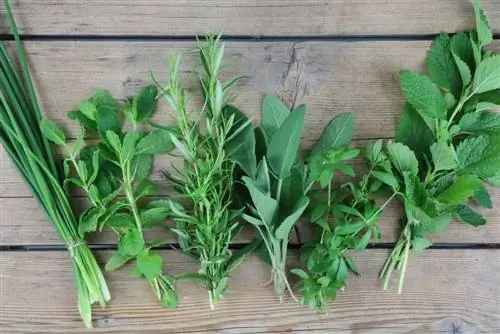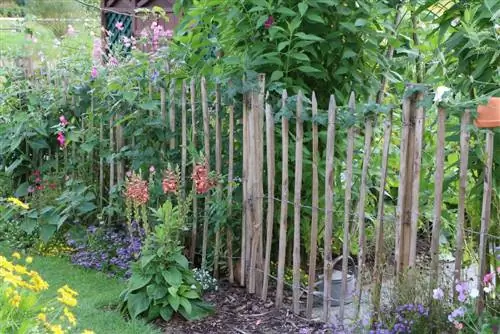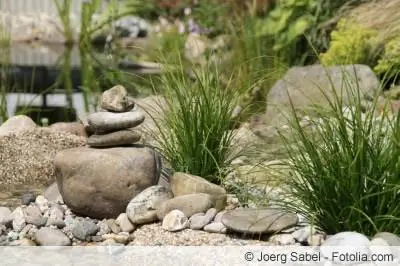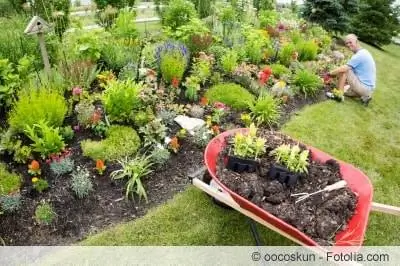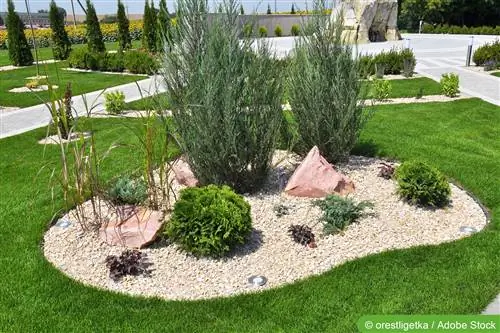- Author admin [email protected].
- Public 2023-12-17 03:39.
- Last modified 2025-06-01 06:48.
Rose beds give your garden the ideal setting to properly celebrate the beauty of the queen of flowers. We learned from the high priests of creative garden design that roses only come into their own with a picturesque entourage. Well-considered planting plans based on themes guarantee a skilful bridge between imaginative flower dreams and color balance, beyond colorful planlessness. These 6 ideas will inspire you to awaken your garden from its slumber with breathtaking rose beds.
Formal garden design - interpreted in rose language
The following planting plan is aimed at gardeners with a penchant for the neat order of formal garden design and the flowery opulence of rose bushes. The masterpiece is achieved by following key design rules for arranging rose beds. With roses as the main protagonist and lush perennials as well as picturesque ornamental trees as an entourage, the plant community presents itself as a harmonious unit. This plant composition is repeated in four beds of equal size that border a crossroads. In this way, the balancing act between the principles of formal garden design and lavish rose magic is achieved:
Floor plan
- 4 rectangular or square beds of the same size
- Frame made of smallBox trees(Buxus sempervirens) orSpoon Ilex (Ilex crenata)
- Crossroads made of 30 to 60 cm wide paths as access and visual separation of the rose beds
- Path surface optionally gravel, bark mulch or natural stone paving
- Rondelle in the crossroads with open ground for planting
- Rose arches at two opposite entrances
Planting plan
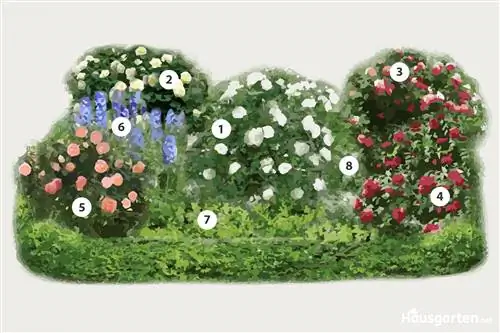
The climbing roses 'Rosarium Uetersen' and 'Sorbet' each wrap around a climbing arch with their pink and apricot-colored flowers. Both rose varieties are highly decorated with the ADR rating and have been proven to be reliably resistant to common diseases. As an eye-catcher in the roundel, the famous floribunda rose 'Sangerhäuser Jubilee Rose' boasts a standard stem with its lush, double, apricot-colored flowers that exude a seductive scent. It shows an excellent sense of style when colors are repeated in exposed areas, as recommended in this planting plan for climbing arches and path crossings. After planting the trellis arches and roundels, turn your attention to the rose bed:
- Main actressIn the middle of the bed is theBedding rose 'Innocencia' (1) with white flowers
- In the four corners, cream yellow'Elina'(2), pink'Acapella'(3) and redshine 'Fragrance Festival'(4) and peach-colored'Augusta Luise' (5)
- MajesticDelphinium 'Blue Bird' (Delphinium cultorum) (6) takes place between 'Elina' and 'Augusta Luise'
- YellowLady's Mantle (Alchemilla mollis) (7) forms the transition between 'Innocencia' and 'Fragrance Festival'
- With white flower clouds,Gypsophila (Gypsophila paniculata) (8) 'Acapella' and 'Elina' lie at your feet
You give this planting plan a playful element if you mirror or twist the arrangement from bed to bed. In this way, a complete rose garden is created from four equivalent beds, beyond formal uniformity.
Tip:
Once roses have finished their flowering festival in autumn, moderate care pruning is on the agenda. Cut back all flower shoots by a maximum of a third. An exception applies to wild roses, which beautify the rose bed with their bright red rose hips well into winter.
Rosary 'Love Magic'
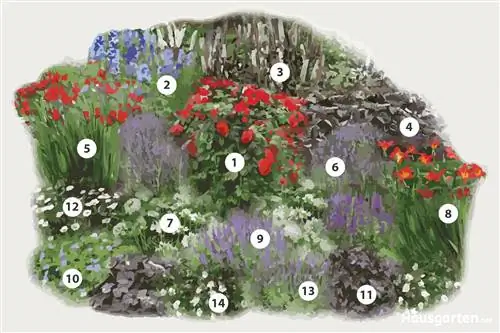
- Planting idea for red floral fireworks -
Use red roses and perennials in matching colors to create a rose bed of timelessly beautiful elegance. A prime example is the richly blooming rose 'Tornella', which delights with velvety red, double flowers that bloom from June to November. With a height of up to 150 cm, the royal beauty has a majestic shape and a unique long-distance effect. As the ideal foot soldiers, perennials with fresh, cool colors such as white and light blue come into focus, complemented by the rich purple of evergreen foliage plants. The following planting plan illustrates the design idea for a bed size of 3 m x 1.5 m:
- In the middle of the bed is theshrub rose 'Tornella' (1)
- Light blueDelphinium(Delphinium) (2),Silberkerze'Brunette' (Cimicifuga simplex) (3) andact as a backdrop. Wasserdost 'Chocolate' (Eupatorium rugosum) (4)
- The rose is flanked by redGiant Montbretia(Crocosmia crocosmiiflora) (5) andBlue diamonds (Perovskia atriplicifolia) (6)
- Transition to the front edge: whiteSpurflowers(Centranthus ruber) (7), redDaylilies(Hemerocallis) (8) and purpleOrnamental sage (Salvia nemorosa) (9)
The elegant rose bed is framed by blueStorksbill(Geranium magnificum) (10), bronze-leavedPurple bells(Heuchera) (11), whiteBeautiful asters(Kalimeris incisa) (12), blueLavender(Lavandula angustifolia) (13) and whiteSunflower(Helianthemum cultorum) (14).
Tip:
The best time to plant a rose bed is in autumn during the months of September and October. Once again, the window for planting roses and accompanying perennials opens in the spring from mid-March and remains open until the beginning of June.
Plant idea 'Snow White'
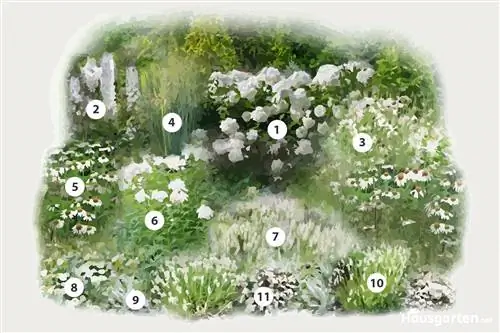
- Fairytale composition and white and green -
The rose bed plays romantic flower chords with a tone-on-tone composition. The leading figure is the world-famous shrub rose 'Snow White' with semi-double, bright white flowers and a height of 100 to 130 cm. From June to September, the white fairytale queen blooms tirelessly on almost thornless, elegantly overhanging rose branches. The following planting plan is intended for a rose bed with a length of 3 meters and a width of 1.5 meters in a triangular shape. The backdrop is an evergreen, sun-drenched hedge corner that illuminates the white sea of flowers.
- Rose 'Snow White' (1) positions itself in the back corner, directly in front of the green backdrop
- Flanked by: whiteDelphinium(Delphinium New Millenium) (2) andwhite candlestick (Gaura lindheimeri) (3)
- FiligreeWedge Millet (Panicum virgatum) (4) provides a green accent between delphinium and 'Snow White'.
- There is space for 2 white-flowering flowers in front of delphiniums and candlesConeflower 'Alba' (Echinacea purpurea) (5)
- WhiteFlameflowers(Phlox paniculata) (6) and whiteOrnamental sage (Salvia nemorosa) (7) form the transition to the edge of the bed
At the edge of the rose bed please place whiteCushion Asters(Aster dumosus) (8), whiteWollziest(Stachys byzantina) (9), whiteLavender(Lavandula angustifolia) (10) and whiteGypsophila (Gypsophila repens) (11), with lower and taller plants in the Change.
Small bed of roses in Sunday attire

- Planting plan ‘Sweet Dream’ -
A magnificent rose bed is not reserved for a spacious park and large garden. In the small garden, the queen of flowers likes to hold court in a sunlit niche. This design idea focuses on the floribunda rose 'Diadem'. The gem blooms several times a year with double, pink flowers that are extremely resistant to rain. The modern variety can also be said to have excellent leaf he alth. For a breathtaking performance, the following planting plan provides you with 3 additional flower beauties. This is how you can create a mini rose bed on 2.5 square meters:
- Bedding rose 'Diadem' (1) towers over the small bed in the background
- At your side is the majestic, blueMeadow Iris (Iris sibirica) (2)
- Pink flowers of thePurple Coneflower (Echinacea purpurea) (3) mark the transition to the front area
At the feet of the three graces lies the blue-purple floweringStorksbill 'Johnsons Blue' (Geranium pratense) (4).
Front garden in a rush of yellow roses

- Planting plan ‘Welcome’ -
The following rose bed welcomes your visitors with a festival of yellow blooms, complemented with contrasting accents of bright blue and purple tones. With this creative front garden design, boring neighboring gardens will be left behind. The plant requirement refers to a base area of 2.5 meters long and 2.5 meters wide. The most important prerequisite for the successful implementation of the planting plan is a sunny location with nutrient-rich, fresh, moist garden soil.
- Middle of the bed:Noble rose 'Landora' (1) with double, yellow flowers and 80 cm height
- Roadside: 2Lady's Mantle(Alchemilla epipsila) (2) take 2 light purpleBluebells (Campanula poscharskyana) (3) in the middle
- Between the edge and the noble rose: 2Gold-edged hostas(Hosta) (4) next to 1 bluePhlox 'Blue Paradise' (Phlox paniculata) (5)
- 2 more lady's mantles flank the noble rose
- The golden yellowYarrow 'Coronation Gold' (Achillea filipendulina) (6) serves as a transition to the rear bed area.
- In the back corner of the bed there is a group of 5Ehrenpreis 'Dark Martje' (Veronica longifolia) (7) with violet flower candles
- 2 gold-edged hostas and a group of three bluebells mark the opposite corner
They add the finishing touch to the sunny yellow welcome when the climbing rose 'Golden Gate' adorns the wall of the house on the trellis or stands out in the large pot with an obelisk at the entrance.
Rosary bed 'Three Seasons'
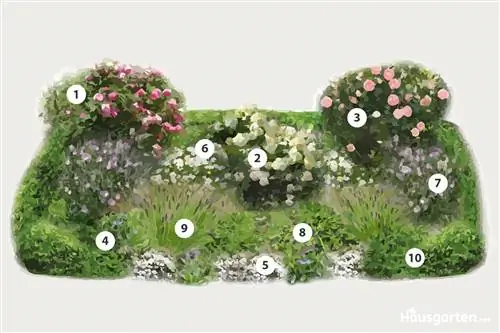
- Design plan for an ever-blooming bed -
In creative garden design, the planting plan for an ever-flowering bed is considered the supreme discipline. Finally, our series of 6 ideas for designing rose beds would like to inspire you to take on the challenge. With modern rose varieties as the floral centerpiece, the course is set for success. In contrast to historical roses, modern breeds are equipped with vital leaf he alth and a never-ending flowering period. Combined with spring, summer and autumn bloomers, the rose bed has more flower surprises in store every season. Let this planting idea inspire you for a bed area 6 meters long and 2 meters wide in a sunny location.
Shopping list:
- 1Noble rose 'Elbflorenz' (1) with double, dark pink flowers, 80-100 cm high: flowering period from June to September
- 1Noble rose 'La Perla' (2) with double, creamy white flowers, 70-90 cm high: flowering period from June to September
- 1Noble rose 'Souvenir de Baden-Baden' (3) with double pink flowers, 90-120 cm high: flowering period June to September
- 15Mountain Knapweed 'Purple Prose' (Centaurea montana) (4): Flowering period from May to July
- 15Gypsophila (Gypsophila paniculata) (5) with white flowers: flowering period from June to August
- 12Summer daisies (Leucanthemum Maximum) (6): Flowering period from July to August
- 12Prairie mallows 'Elsie Heugh' (Sidalcea malviflora) (7) with light pink flowers: flowering period from July to September
- 8Cushion Asters 'Heinz Richard' (Aster dumosus) (8) with pink flowers: blooms in September and October
- 4Pennisetum 'Hameln' (Pennisetum alopecuroides) (9) with brown spike flowers from August to October
- 40Dwarf Yews (Taxus baccata) (10) Renke's Kleiner Grüner' as a border hedge
Planting plan
The noble roses are placed in prominent places across the bed. As a harbinger, mountain knapweed flowers bloom from May onwards and are found in several groups of three throughout the area. When the rose petals unfurl in June, the picturesque gypsophila begins with a white floral flor, arranged in 5 groups of 3 specimens each along the border. With a growth height of 80 cm, summer daisies take their place in the background of the bed or stand alongside the noble roses. Prairie hollyhocks with pink flowers peek out between roses and border plants and accompany the rose blossom festival into autumn.
Cushion asters initially only show their leaves in the foreground of the bed, only to bloom from September onwards, when their neighbors' flowering season is coming to an end. The end of the season is filled with Pennisetum grasses, loosely arranged amidst the blossoms. Following the subtle flowering of the spikes, their brown cobs provide decorative accents until winter. The frame of this plant composition is formed by dwarf yews of the variety 'Renke's Kleiner Grüner', which have emerged as an ideal alternative to box trees for bordering beds.

